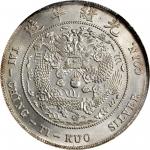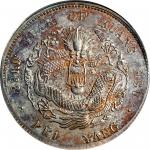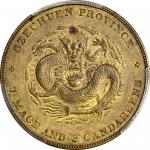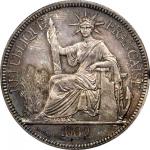The inaugural flight of the United States Air Post service between Washington and New York via Philadelphia was scheduled for May 15th, 1918. The rate was set at 24c; 2c for postage, 12 cents for air mail service, and 10c for special delivery. To commemorate the event the Post Office decided to produce a specially ordered air post issue for the occasion. The stamp was to be bi-colored depicting a blue Curtis JN4HM "Jenny" biplane set within a carmine red frame containing the 24 CENTS denomination and U.S. POSTAGE. The production was swift; the engraving only began on May 4th, yet the stamps, printed in sheets of 100, were available at Post Offices on May 13th.In Washington D.C. on May 10th, 1918 a stamp collector remarked in a letter to a friend that "one should be on the lookout for inverts". He was referring to the rare inverted center stamps that had occurred in 1869 and 1901 when the Post Office had previously issued bi-colored postage stamps. The Post Office was still acutely aware of the embarrassment caused when three of the six stamps issued for the Pan American exhibition of 1901 had turned up with inverted centers on the philatelic market. It is said that as many as three sheets of 24c inverts were discovered and destroyed during the printing of the new Air Post issue.The writer of the letter, a twenty eight year old clerk named William T. Robey, walked into his local Post Office on New York Avenue on the morning of May 14th, 1918 to purchase a sheet of the new stamps. To his complete astonishment each of the one hundred vignettes of the blue "Jenny" biplane were printed upside down. Hardly believing his luck he immediately asked the clerk to let him examine the entire stock of the new stamps for further examples, there were none. Shortly after returning home with his precious $24.00 purchase he received a visit from a United States postal inspector who demanded the return of the stamps. Robey refused to part with his treasure and very quickly made plans to sell the sheet. Within a week he was $15,000.00 richer and the stamps were in the possession of Eugene Klein, a noted Philadelphia stamp dealer. Klein quickly set about advertising the stamps for sale; $250 each for the stamps with perforations on all sides, $175.00 for the nineteen copies at the top and right of the sheet with straight edges. However, before a single stamp had sold, a collector arrived and purchased the entire sheet for $20,000.00. His name was Colonel Edward Howland Robinson Green. Colonel Edward "Ned" Green was probably the most famous accumulator of both stamps and coins during the first half of the twentieth century. Born in England in 1868 he was the only son of Henrietta "Hetty" Green the so-called "Witch of Wall Street". Despite being one of, if not the richest woman in America, Hetty Green was equally famous as the most miserly. She lived a parsimonious life and raised her son and daughter in a state of austerity. Ned spent his early adult life working in the family business and was successful, allowing him to substantially improve the standard of living he had endured in the earlier part of his life. By 1892 he was based near Dallas, Texas and taking an interest in Railroads, Banks, and Politics. In 1910 he was awarded the rank of Colonel by the Governor of Texas; he retained the title for the rest of his life.He remained unmarried well into his forties with his mother doing her utmost to deter potential suitors thinking them all gold diggers. His sister was finally permitted to marry a member of the Astor family at the age of thirty-eight. Ned Green met Mabel Harlow for the first time in Chicago in the early 1890 s while, among several occupations, she was working as an exotic dancer. The relationship was brief. Nevertheless she made such an impression that when they reunited in Texas more than fifteen years later they immediately became a couple. Her status as his "Housekeeper" caused quite a scandal at the time and it is known that Hetty, back in New York, referred to her as Miss Harlot. In July 1916 Hetty Green died and Ned inherited $50,000,000.00, exactly one year and one week later Ned married Mabel in Chicago. In complete contrast to his late mother Ned Green began to spend. He spent money on everything but he especially liked spending his inheritance on stamps, coins, cars, and Mabel.Ned had been married for a little over ten months when he purchased the sheet of inverted "Jennies" for $20,000.00 from Eugene Klein. At the time this was a world record for any philatelic item, and would stand until the Ferrary Sales began in France in 1922. The sheet was almost immediately broken into blocks and singles with Green retaining, among others, the major position blocks and the top row of the sheet with the straight edges from where the "locket" copy (position 9) originates. Before separating the stamps Klein carefully numbered all the stamps from 1-100 on reverse in light pencil.It was often rumored that Colonel Green always carried a copy of the "Jenny" attached to his watch fob. Following his death in 1936 and the subsequent auction sales of his philatelic holdings during the 1940 s no trace was ever found of this artifact. Not until June 1950 when renowned philatelic journalist George Sloane was called to a midtown bank to examine an estate item found in a safety deposit box was the mystery solved. Sloane recalled the visit in a column from July 7 1956: "It was the estate of the late Mrs. E. H. R. Green, widow of the Colonel". The item in question was; "a crystal locket containing a 24c airmail invert, enclosed with the normal variety of the stamp". The locket was not opened, and, according to Sloane, forwarded to the beneficiary.When Mabel Green died in Miami at age 79 in April 1950 she bequeathed the locket to her longtime companion Dorothy Nicholson. Dorothy moved to Long Island, later marrying a New York lawyer named Lester Stickles, the locket remained in a safety deposit box in New York. As the years passed collectors began recording all the known positions from the sheet from the numbers Eugene Klein had penciled on the backs of the stamps in 1918. Only one stamp from the top row eluded the researchers; position 9. In an interesting twist position 18 from the Miller collection housed at the New Public Library was stolen in 1977 along with 53 other rare stamps. Recovered in the early 1980’s its perforations had been removed at top and its number on the reverse had been altered from 18 to the missing number 9. Finally on December 26th 1984, George Amick, author of The Inverted Jenny, Money, Mystery, Mania (1986) was permitted to photograph the locket for the first time. By comparison to the adjoining stamps it was confirmed as the missing position.Dorothy Stickles died at age 90 in 2001 and the stamp was brought to market for the first time in its history. It has sold privately twice in the intervening years firstly in 2003 to an unnamed collector by Robert A. Siegel Inc. for $90,000.00 and secondly, in 2009 to the present owner. During expertizing for the 2010 PSE certificate, the locket was opened for the first time this century. Experts confirmed that the two stamps were totally separate despite being gum to gum for over ninety years, and actually floated freely within the confines of the locket. Klein’s manuscript 9" was also revealed for the first time.EXTREMELY FRESH BRIGHT VIBRANT COLORS, ONE OF ONLY FIVE KNOWN NEVER HINGED EXAMPLES, FINE with 2010 Professional Stamp Experts certificate., Est. $100,000-$200,000



















